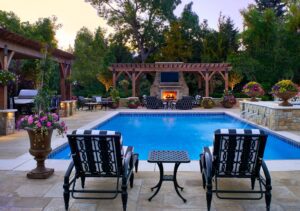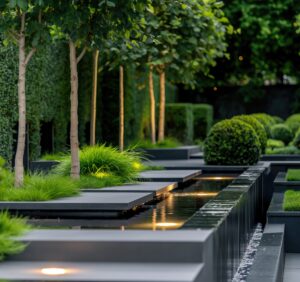Transforming your outdoor space into a functional, beautiful extension of your home requires expertise that goes beyond casual gardening knowledge. Professional landscape designers bring specialized skills that blend artistic vision with practical know-how, creating outdoor environments that enhance both your lifestyle and property value.
When considering a landscape renovation or complete property transformation, working with a qualified designer can make the difference between a disappointing outcome and a stunning, sustainable landscape that brings joy for years to come.
Browne Associates knows that selecting the right landscape designer represents a significant decision that impacts not only your property’s aesthetics but also its functionality, maintenance requirements, and long-term value. This guide will walk you through the essential considerations for hiring a landscape professional who aligns with your vision, budget, and expectations.
The Value of Professional Landscape Design
Beyond Aesthetic Enhancement
A professional landscape designer delivers far more than just visual improvements to your property. While beautiful gardens and outdoor spaces certainly result from expert design, the underlying value extends into multiple aspects of property ownership.
Professional designers approach your landscape as an integrated system that balances aesthetic appeal with practical functionality, environmental sustainability, and long-term investment protection.
Recent studies from 2025 indicate that professionally designed landscapes can increase property values by 5-20%, often recovering 100-200% of their costs at the time of sale. This return on investment significantly exceeds typical DIY approaches, which frequently lack the cohesive vision and technical expertise that maximize property enhancement.
The financial benefits extend beyond resale value to include potential energy savings through strategic tree placement, reduced water usage through efficient irrigation design, and decreased maintenance costs through appropriate plant selection.
Beyond financial considerations, professionally designed landscapes create environments that enhance mental well-being and quality of life. Research consistently demonstrates that thoughtfully designed outdoor spaces reduce stress, improve cognitive function, and provide opportunities for relaxation and social connection.
These psychological benefits represent substantial value that, while less quantifiable than property appreciation, significantly impact daily enjoyment of your home environment.
Expertise and Technical Knowledge
Landscape designers bring specialized technical knowledge that ensures your outdoor space functions properly while looking beautiful. This expertise encompasses understanding of soil conditions, drainage requirements, plant compatibility, and climate considerations that affect long-term landscape success. Without this technical foundation, even visually appealing designs may develop serious problems that require costly corrections.
Professional designers possess comprehensive knowledge of plant materials suitable for your specific region and microclimate. They understand growth patterns, maintenance requirements, seasonal changes, and plant combinations that create visual interest throughout the year.
This horticultural expertise prevents common mistakes like overcrowding, inappropriate plant selection, or combinations that look good initially but become problematic as plants mature.
The technical aspects of landscape design extend beyond plant selection to include proper grading, drainage solutions, irrigation systems, lighting design, and hardscape integration. These elements require specialized knowledge of materials, construction techniques, and building codes that most homeowners lack.
Professional designers coordinate these technical components into cohesive plans that address both visible aesthetics and invisible infrastructure essential for landscape success.
Key Considerations When Selecting a Landscape Designer
Portfolio and Past Work
Examining a landscape designer’s previous projects provides valuable insight into their style, capabilities, and attention to detail. Most reputable designers maintain portfolios showcasing their work, either through websites, social media platforms, or physical portfolios they can share during consultations.
These visual examples reveal not only aesthetic preferences but also the types of challenges they’ve successfully addressed in past projects.
When reviewing portfolios, look beyond simple visual appeal to consider projects similar to your own in terms of property size, style, or specific features you desire. Pay attention to how the designer integrates various elements like plantings, hardscapes, water features, and lighting to create cohesive environments.
The best portfolios show projects from multiple angles and, ideally, at different stages of maturity to demonstrate how designs develop over time.
Many designers can provide addresses of completed projects (with client permission) that allow you to view their work in person. This firsthand observation proves particularly valuable as it reveals details that photographs might not capture, such as how spaces flow together, the scale of various elements, and how the design integrates with surrounding architecture.
If possible, visit these properties at different times of day to understand how lighting affects the space and how the design functions in various conditions.
References and Credentials
Verifying a landscape designer’s professional background through references and credentials represents an essential step in the selection process. Reputable designers willingly provide references from previous clients who can speak to their experience working with the designer throughout the entire project lifecycle.
When contacting these references, ask specific questions about communication style, adherence to budgets and timelines, problem-solving abilities, and overall satisfaction with both the process and results.
Professional credentials indicate a designer’s commitment to industry standards and continuing education. Look for affiliations with organizations like the Association of Professional Landscape Designers (APLD), American Society of Landscape Architects (ASLA), or regional professional associations.
Many qualified designers hold degrees in landscape architecture, horticulture, or related fields, while others may have completed certification programs specific to landscape design.
Beyond formal credentials, consider the designer’s local experience and reputation within your community. Designers familiar with local conditions, building codes, and available resources often navigate projects more efficiently than those new to the area. Local knowledge particularly matters for understanding microclimate variations, soil conditions, and plant performance specific to your region.
Community reputation, often reflected in online reviews or local business awards, provides additional verification of a designer’s reliability and quality of work.
Communication and Personal Connection
The relationship between homeowner and landscape designer requires effective communication and a comfortable personal connection. Since landscape projects often extend over months or even years (including maintenance phases), selecting someone with whom you communicate well becomes capital for long-term satisfaction.
Initial consultations provide opportunities to assess how well a designer listens to your ideas, addresses your concerns, and translates your vision into concrete proposals.
Pay attention to how thoroughly the designer asks questions about your lifestyle, preferences, and how you intend to use your outdoor spaces. Exceptional designers invest time understanding not just what you want visually, but how you live and what functionality you need from your landscape.
This client-centered approach indicates a designer who creates custom solutions rather than imposing predetermined styles or concepts regardless of client needs.
The designer’s ability to explain complex concepts in understandable terms also indicates their communication effectiveness. They should clearly articulate the reasoning behind their recommendations, potential challenges they foresee, and options for addressing various aspects of your project. This transparency builds trust and ensures you make informed decisions throughout the design and implementation process.
Remember that the most beautiful design on paper holds little value if the designer cannot effectively collaborate with you to bring it to reality.
Understanding the Design Process
Initial Consultation and Site Analysis
The landscape design process typically begins with an in-depth consultation where the designer learns about your goals, preferences, budget, and timeline. This initial meeting establishes the foundation for the entire project and provides an opportunity for both parties to determine whether they can work effectively together.
Professional designers use this time to explain their process, fee structure, and what you can expect throughout the project timeline.
Following the consultation, designers conduct a comprehensive site analysis to understand the existing conditions that will influence design decisions. This analysis typically includes measuring the property, documenting existing features to remain, identifying views to enhance or screen, noting drainage patterns, assessing soil conditions, and evaluating sun exposure throughout the day.
Many designers also photograph the property from multiple angles to reference during the design development phase.
The site analysis may also include research into local regulations, homeowner association requirements, or permit processes that could affect the project. This thorough investigation prevents surprises later in the process and ensures the design addresses both your aesthetic desires and the site’s practical realities.
A detailed site analysis represents a critical investment of time that significantly improves the resulting design’s functionality and integration with existing conditions.
Design Development and Presentation
Once the site analysis is complete, the designer begins developing concepts that address your goals while working within the site’s opportunities and constraints. This creative process typically progresses from broad conceptual ideas to increasingly detailed plans as the design evolves. Many designers present multiple concepts initially, allowing you to provide feedback that guides further refinement toward the final design.
The presentation format varies between designers, with options ranging from hand-drawn sketches to computer-generated renderings or 3D visualizations. These visual tools help you understand how the proposed design will look and function in reality. The most effective presentations include both overall plans showing the complete design and detailed views of specific areas or features that require closer examination.
During design presentations, professional designers explain not just what they’ve designed but why they’ve made specific recommendations. This rationale might include plant selections based on site conditions, material choices that complement your home’s architecture, or spatial arrangements that maximize functionality.
This transparent approach allows you to make informed decisions about various design elements and ensures the final plan truly reflects your priorities and preferences.
Implementation Planning and Oversight
The final phase of the design process involves detailed planning for implementation, including development of construction documents, material specifications, planting plans, and other technical information needed by contractors. These documents translate the design concept into specific instructions that guide the physical creation of your landscape.
The level of detail in these plans directly affects the accuracy of contractor bids and the quality of the finished landscape.
Many landscape designers offer project oversight services during implementation, serving as your advocate to ensure contractors execute the design as intended. This oversight might include regular site visits, consultation on field adjustments, quality control inspections, and problem-solving when unexpected issues arise during construction.
While this service typically involves additional fees, it often proves invaluable for achieving the highest quality results, especially for complex projects.
The implementation planning phase also includes development of maintenance guidelines that help preserve your landscape’s beauty and functionality over time. These guidelines might specify watering schedules, pruning techniques, fertilization recommendations, and seasonal care requirements specific to your new landscape.
This information ensures you understand how to protect your investment and maintain the designer’s vision as plants mature and the landscape evolves.
Cost Considerations and Budget Planning
Fee Structures and Pricing Models
Landscape designers utilize various fee structures depending on their business model, project complexity, and services provided. Understanding these different approaches helps you evaluate proposals and select an arrangement that aligns with your project needs.
Common fee structures include hourly rates, flat fees for specific services, percentage-based fees calculated from the total project budget, or combinations of these approaches for different project phases.
Hourly rates typically range from $75-200 per hour depending on the designer’s experience, credentials, and regional market factors. This approach works well for smaller projects or when the scope remains somewhat undefined at the outset. Flat fees provide more certainty for budget planning and often apply to specific deliverables like concept plans, planting designs, or construction documents.
Percentage-based fees, usually ranging from 8-15% of the total implementation budget, align the designer’s compensation with the project’s overall scope and complexity.
When evaluating fee proposals, consider the value received rather than focusing solely on the lowest price. More experienced designers may charge higher rates but often deliver greater value through efficient processes, innovative solutions, and fewer costly mistakes during implementation.
Additionally, comprehensive proposals that clearly define deliverables, revision allowances, meeting schedules, and additional service costs indicate professional business practices that typically translate to smoother project execution.
Value Engineering and Phased Implementation
Professional landscape designers help maximize your investment through strategic planning approaches that deliver the greatest value within your budget constraints. Value engineering involves analyzing design elements to identify opportunities for cost savings without compromising essential functions or aesthetic quality.
This process might include material substitutions, simplified construction methods, or alternative plant selections that achieve similar effects at lower costs.
For projects where the desired design exceeds available funds, phased implementation offers a practical solution that maintains design integrity while spreading costs over time. This approach begins with a comprehensive master plan that establishes the complete vision, then divides implementation into logical phases that function well independently while building toward the ultimate design.
Proper phasing requires careful planning to avoid damaging completed areas during later construction phases and to ensure each phase provides immediate enjoyment while the complete vision gradually unfolds.
Budget transparency throughout the design process helps prevent disappointment and ensures realistic expectations. Professional designers discuss budget considerations openly from the initial consultation and provide cost estimates at appropriate intervals as the design develops.
This ongoing dialogue allows for adjustments before significant investment in detailed design work and helps prioritize elements that deliver the greatest value for your specific priorities and circumstances.
Maximizing Your Designer Relationship
Preparation and Clear Communication
Preparing thoroughly before meeting with potential landscape designers significantly improves the consultation process and helps identify the best match for your project. Consider creating a project vision board that collects images of landscapes you admire, specific features you desire, and styles that appeal to you.
This visual reference helps designers understand your aesthetic preferences more clearly than verbal descriptions alone.
Develop a prioritized list of functional requirements and desired features for your landscape. This might include entertainment spaces, play areas, vegetable gardens, privacy screening, or specific activities you want to accommodate. Ranking these elements helps designers understand which aspects matter most when budget constraints require trade-offs or phased implementation.
Additionally, be prepared to discuss realistic budget parameters – even approximate ranges help designers recommend appropriate scope and solutions.
Clear communication extends beyond initial meetings to the entire project timeline. Establish preferred communication methods and reasonable expectations for response times at the outset. Provide prompt, specific feedback on design proposals rather than vague reactions that leave designers guessing about your preferences.
When concerns arise, address them directly rather than allowing dissatisfaction to build. Professional designers welcome constructive feedback that helps refine their work to better meet your needs.
Leveraging Designer Expertise
Professional landscape designers bring valuable specialized knowledge that extends beyond aesthetic considerations to include technical expertise, industry connections, and problem-solving capabilities. Maximizing the value of your designer relationship involves recognizing and utilizing these resources throughout your project.
Technical expertise includes understanding of soil science, plant physiology, drainage engineering, construction methods, and material performance that affects long-term landscape success. Rather than overriding these recommendations based on personal preferences alone, consider the reasoning behind designer suggestions and the potential long-term implications of alternative choices.
The most successful projects balance aesthetic desires with technical realities through collaborative problem-solving.
Industry connections represent another valuable designer resource that can enhance your project outcomes. Established designers maintain relationships with quality contractors, specialty material suppliers, and horticultural sources that might be unavailable to the general public.
These connections often translate to better pricing, higher quality materials, and more reliable implementation. Additionally, designers can recommend maintenance professionals who understand how to preserve the design intent as your landscape matures.
FAQ: Hiring a Landscape Designer
1. How much does hiring a landscape designer typically cost?
Landscape design fees vary based on project scope, designer experience, and regional markets. Typical costs range from $2,000-$7,000 for design services on average residential properties, with larger or complex projects potentially exceeding $10,000. Most designers charge either hourly rates ($75-200/hour), flat fees for specific deliverables, or percentage-based fees (8-15% of total project budget).
Initial consultations may be complimentary or cost $100-300, sometimes credited toward design services if you proceed. Remember that design fees typically represent 5-15% of total project cost but significantly improve implementation efficiency and long-term satisfaction.
2. What’s the difference between a landscape designer and landscape architect?
Landscape architects typically hold professional degrees and state licenses requiring rigorous education and examination. They often handle complex projects involving extensive engineering, large commercial sites, or significant environmental challenges. Landscape designers may have varied educational backgrounds from horticulture to design certificates, focusing primarily on residential and smaller commercial projects.
Both can create beautiful, functional landscapes, but architects generally command higher fees reflecting their credentials. For typical residential projects, a qualified landscape designer often provides the ideal balance of expertise and value unless complex engineering or permitting issues require an architect’s credentials.
3. How long does the landscape design process typically take?
The design timeline varies based on project complexity and designer workload. For average residential projects, expect 4-8 weeks from initial consultation to final design documents. This typically includes: 1-2 weeks for site analysis and concept development, 2-3 weeks for preliminary design and revisions, and 1-3 weeks for final documentation.
Larger projects or those requiring multiple revision rounds may extend to 3-4 months. Implementation timelines vary even more dramatically based on project scope, from a few weeks for simple gardens to several months for comprehensive landscape transformations. Weather conditions and contractor availability also affect implementation schedules.
4. Should I hire a designer who also handles installation, or keep these services separate?
Both approaches offer distinct advantages. Design-build firms provide seamless transitions from design to implementation with single-point accountability and potentially smoother communication. Independent designers who focus exclusively on design may offer greater objectivity, more diverse style options, and the ability to obtain competitive bids from multiple contractors.
The best choice depends on your priorities – if simplicity and coordination matter most, design-build firms excel. If you prefer maximum design creativity and competitive pricing, separate services might work better. Regardless of approach, verify that all parties have successful experience with your project type.
5. What information should I prepare before my first meeting with a landscape designer?
Prepare a project wish list prioritizing must-have versus nice-to-have elements, photos of landscapes you admire, and images of your existing space. Gather information about property boundaries, known utilities, irrigation systems, and any HOA restrictions. Have a realistic budget range in mind, even if approximate.
Consider your maintenance preferences – low-maintenance naturalistic gardens versus manicured formal spaces require different approaches. Think about how you actually use outdoor spaces versus aspirational ideas. Bring questions about the designer’s process, timeline, and fee structure. This preparation demonstrates seriousness about your project and helps designers provide more accurate initial feedback.
6. How involved should I be in the design process?
Successful landscape design requires balanced collaboration between homeowner and designer. Your input is essential regarding functional needs, aesthetic preferences, budget constraints, and maintenance capacity. However, allowing the designer creative freedom to solve problems and propose unexpected solutions often yields the most innovative results.
The best approach involves clear communication about your priorities and constraints while remaining open to professional recommendations that might challenge preconceptions. Regular feedback at designated milestones keeps the project aligned with your vision while respecting the designer’s expertise. This collaborative balance typically produces the most satisfying outcomes that truly enhance your property and lifestyle.



